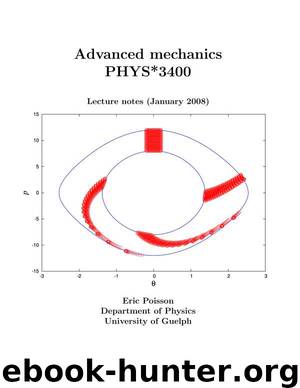Advanced mechanics by Eric Poisson

Author:Eric Poisson
Language: eng
Format: epub
Tags: Advanced Mechanics,
(2.5.3)
and a statement of conservation follows immediately:
Whenever L does not depend explicitly on time, so that dL/dt = 0, we have that
h(q a , q a ) = ^Paia - L (2.5.4)
a
is a constant of the motion, dh/dt = 0.
Surely the function h(q a , q a ) must have something to do with the system's total mechanical energy. Let us first figure out the relationship in the context of a simple example. We go back to the Lagrangian of a particle expressed in cylindrical coordinates,
L= l -m{p 2 + p 2 4> 2 + z 2 )-V{p,cj > ,z),
2.5 Generalized momenta and conservation statements
83
but this time we place no constraints on the potential energy. The generalized momenta are p p = mp, p<p = mp 2 <j), and p z — mz. We then have
h = P P P + P<t>4> + Pz* ~ L
= mp 2 + mp 2 <\> 2 + mz 2 - ^m(p 2 + p 2 (j) 2 + z 2 ) + V(p, (f>, z)
= \m{p 2 +p 2 4> 2 + z 2 ) + V{p,^,z).
This is indeed the total mechanical energy, the sum of kinetic and potential energies.
To verify that h(q ai q a ) is always equal to the total mechanical energy we use the fact that the kinetic energy is usually a quadratic function of the generalized velocities,
T = ^^2A ab q a q b .
a, b
The coefficients A ab may in general depend on the coordinates q a , and without loss of generality we may assume that A ba = A ab . The Lagrangian is then
L = \ ^A ab q a q b - V{q a )
2
a.b
The generalized momentum p a is obtained by differentiating L with respect to q a . To see what this amounts to let us consider a special case in which the mechanical system possesses three degrees of freedom. In this case we have, explicitly,
L = \ All< il + ^129192 + -4139143 + 7,A 22 q 2 + ^23^293 + ^3393 ~ V {<lU 92, 93)-
It follows that
FIT,
= A n qi + A 12 q 2 + A 13 q 3 , = Ai 2 qi + A 22 q 2 + A 23 q 3 ,
= ^1391 + -42392 + A 33 q 3 are the generalized momenta. These relations are summarized by
Pa = ^A ab q b ,
b
and the same expression is always obtained, regardless of the number of degrees of freedom. The function h is then
h = ^2Pa4a-L
a
= ^2(^2A ab q b jq a - ^2,A ab q a q b + V{q a )
\ U / „ h
a.b
= ]^^A ab q a q b + V(q a ),
a, b
and we conclude that
Hq a , q a ) = T(q a , q a ) + V{q a ) = total mechanical energy. (2.5.5)
In all generality, therefore, the function h is the system's total energy, and this is conserved whenever L does not depend explicitly on time.
Download
This site does not store any files on its server. We only index and link to content provided by other sites. Please contact the content providers to delete copyright contents if any and email us, we'll remove relevant links or contents immediately.
The Complete Stick Figure Physics Tutorials by Allen Sarah(7307)
Secrets of Antigravity Propulsion: Tesla, UFOs, and Classified Aerospace Technology by Ph.D. Paul A. Laviolette(5309)
Thing Explainer by Randall Munroe(3877)
The River of Consciousness by Oliver Sacks(3540)
The Order of Time by Carlo Rovelli(3145)
How To by Randall Munroe(3035)
A Brief History of Time by Stephen Hawking(2960)
I Live in the Future & Here's How It Works by Nick Bilton(2935)
The Great Unknown by Marcus du Sautoy(2648)
What If?: Serious Scientific Answers to Absurd Hypothetical Questions by Randall Munroe(2637)
Midnight in Chernobyl by Adam Higginbotham(2483)
Blockchain: Ultimate Step By Step Guide To Understanding Blockchain Technology, Bitcoin Creation, and the future of Money (Novice to Expert) by Keizer Söze(2446)
Networks: An Introduction by Newman Mark(2360)
The Meaning of it All by Richard Feynman(2300)
Easy Electronics by Charles Platt(2281)
The Tao of Physics by Fritjof Capra(2231)
Midnight in Chernobyl: The Untold Story of the World's Greatest Nuclear Disaster by Adam Higginbotham(2177)
When by Daniel H Pink(2083)
Introducing Relativity by Bruce Bassett(2077)
